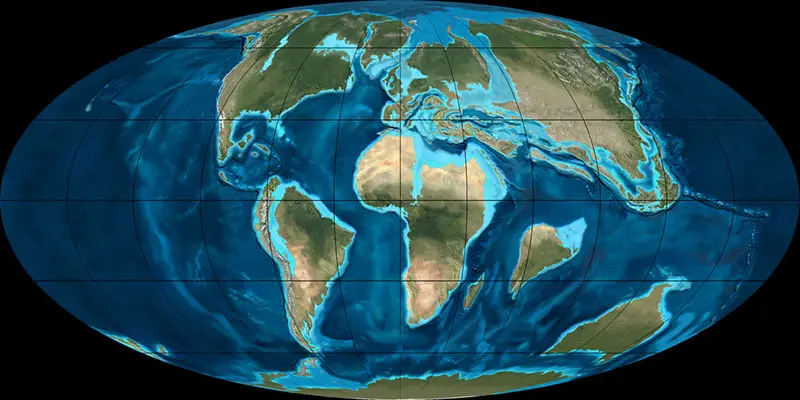†Plesiolestes (Palaechthonidae)
Plesiolestes ist eine Primatengattung innerhalb der Familie Palaechthonidae, deren 5 Mitglieder ab dem frühen Paläogen (Paläozän) im Danium lebten, das vor ungefähr 66 Millionen Jahren begann und bis vor 61,6 Millionen Jahren andauerte. Viele Überreste wurden in Vereinigte Staaten von Amerika (USA) gefunden.
Die Gattung Plesiolestes umfasst drei Arten ausgestorbener Primaten (Familie Palaechthonidae innerhalb der Ordnung Plesiadapiformes), die vom mittleren bis späten Paläozän in Nordamerika lebten. Die Funde sind zwischen 63,3 und 60,2 Millionen Jahre alt.
Plesiolestes nacimienti
Der kleine Primate lebte vom mittleren bis späten Paläozän in Nordamerika und war ein baumlebender Allesfresser, der sich hauptsächlich von Insekten ernährte. Basierend auf der Größe und Morphologie der Backenzähne schätzen Wissenschaftler das Gewicht des kleinen Säugetiers auf 408,8 Gramm.
| Sammlung | Kommentar zum Fundort | Epoche, Alter | Geologie, Formation | Kommentar zur Sammlung |
|---|---|---|---|---|
| Big Pocket | Nacimiento | Angels Peak; KUVP Loc. 13; Locality NM 13; NMMNH 2635; UALP 7435, 7436, 75144; NMMNH locality L-2635 | ||
| Kommentar z. Stratigraphie | Lithographie | Kommentar z. Taxonomie | ||
| from "a zone... three to four feet in thickness... The actual bone layer, not as yet located, may prove to be thinner than this" (Wilson 1951) not far below the middle of a reversed magnetic polarity zone in the Kutz Canyon section interpreted as C27r based on the position of the K-T boundary in the correlative Barrel Spring Arroyo = De-na-zin Wash section: see Butler et al. 1977, Lucas et al. 1997 | "reddish silt" (Wilson 1951) | UALP localities are at exactly the same level as KUVP 13 but may be at some distance\r\nfollowing taxa listed by Williamson and Lucas may be from Big Pocket or a stratigraphically nearby locality: ? Peradectes sp. "D" Pentacodon inversus Protictis haydenianus "Protictis" sp. "A" Protictis (Protictis) sp. "B" Triisodon quivirensis Ellipsodon inaequidens |
Plesiolestes problematicus
Das Typusexemplar mit der Bezeichnung Princeton No. 13291 ist ein rechter Unterkiefer mitsamt einem Prämolaren (P3) und Molaren (M1-3). Der Fund stammt aus dem Rock Bench Steinbruch in Wyoming und ist zwischen 63,3 und 60,2 Millionen Jahre alt.
| Sammlung | Kommentar zum Fundort | Epoche, Alter | Geologie, Formation | Kommentar zur Sammlung |
|---|---|---|---|---|
| Swain Quarry | Fort Union | CM loc 217 | ||
| Kommentar z. Taxonomie | ||||
| there are seven other localities in the same section, but none of the material is described\r\nMesodma pygmaea, i.e. sp. P, not listed, but mentioned by Krause 1977 |
| Physiologie | |
|---|---|
| Gewicht: | ? |
| Schwestertaxa | |
Plesiolestes wilsoni
Der kleine Allesfresser ernährte sich unter anderem von Insekten.
Literatur
F. S. Szalay 1973, New Paleocene Primates and a diagnosis of the new suborder Paromomyiformes. Folia Primatologica. 19, p. 73 - 87J. K. Rigby, Jr. 1980, Swain Quarry of the Fort Union Formation, Middle Paleocene (Torrejonian), Carbon County, Wyoming: geologic setting and mammalian fauna. Evolutionary Monographs. 3, p. 1 - 178
K. D. Rose 1981, The Clarkforkian Land-Mammal Age and Mammalian Faunal Composition Across the Paleocene-Eocene Boundary. University of Michigan Papers on Paleontology. 26, p. 1 - 197
L. H. Taylor 1981, The Kutz Canyon Local Fauna, Torrejonian (Middle Paleocene) of the San Juan Basin, New Mexico;. Advances in San Juan Basin Paleontology. , p. 242 - 263
G. F. Gunnell 1989, Evolutionary History of Microsyopoidea (Mammalia, ?Primates) and the Relationship Between Plesiadapiformes and Primates. University of Michigan Papers on Paleontology. 27, p. 1 - 157
T. E. Williamson, S. G. Lucas 1993, Paleocene vertebrate paleontology of the San Juan Basin, New Mexico. New Mexico Museum of Natural History Bulletin. 2, p. 105 - 136
J. Alroy, S. G. Lucas 2002, Synonymies and reidentifications of North American fossil mammals. . , p. - 136
C. S. Scott, S. G. Lucas 2003, Late Torrejonian (middle Paleocene) mammals from south central Alberta, Canada. Journal of Paleontology. 77:4, p. 745 - 768
C. S. Scott, D. N. Spivak, A. R. Sweet 2013, First mammals from the Paleocene Porcupine Hills Formation of southwestern Alberta, Canada. Canadian Journal of Earth Sciences. 50:4, p. 355 - 378
D. T. Ksepka, T. A. Stidham, T. E. Williamson 2017, Early Paleocene landbird supports rapid phylogenetic and morphological diversification of crown birds after the K–Pg mass extinction. Proceedings of the National Academy of Sciences. 114:30, p. 8047 - 8052, DOI: 10.1073/pnas.1700188114
E. K. Halverson, J. J. Eberle, T. E. Williamson 2018, A new middle Paleocene (early Tiffanian) mammalian fauna from the Overland Member of the Fort Union Formation, Great Divide Basin, Wyoming, U.S.A. . Rocky Mountain Geology. 53:2, p. 75 - 111, DOI: 10.24872/rmgjournal.53.2.75
